brake light TOYOTA tC 2014 Owners Manual (in English)
[x] Cancel search | Manufacturer: TOYOTA, Model Year: 2014, Model line: tC, Model: TOYOTA tC 2014Pages: 488, PDF Size: 9.33 MB
Page 2 of 488

TABLE OF CONTENTSIndex
2
tC_OM_OM21046U_(U)
1-1. Key informationKeys ..................................... 26
1-2. Opening, closing and locking the doors
Smart key system................. 30
Wireless remote control ....... 48
Side doors ............................ 53
Back door ............................. 60
1-3. Adjustable components (seats, mirrors, steering
wheel)
Front seats ........................... 66
Rear seats ............................ 72
Head restraints ..................... 74
Seat belts ............................. 76
Steering wheel ..................... 83
Anti-glare inside rear view mirror .................................. 84
Outside rear view mirrors ..... 86
1-4. Opening and closing the windows and moon roof
Power windows .................... 88
Moon roof ............................. 92
1-5. Refueling Opening the fuel tank cap .... 96 1-6. Theft deterrent system
Engine immobilizer system .............................. 101
Theft prevention labels (for U.S.A.) ....................... 104
1-7. Safety information Correct driving posture ....... 105
SRS airbags ....................... 107
Front passenger occupant classification system ......... 122
Child restraint systems ....... 128
Installing child restraints ..... 134
2-1. Driving procedures Driving the vehicle .............. 150
Engine (ignition) switch (vehicles without a smart
key system) ...................... 165
Engine (ignition) switch (vehicles with a smart
key system) ...................... 169
Automatic transmission ...... 178
Manual transmission........... 185
Turn signal lever ................. 187
Parking brake ..................... 188
Horn .................................... 189
2-2. Instrument cluster Gauges and meters ............ 190
Indicators and warning lights ................................. 194
1Before driving
2When driving
Page 149 of 488
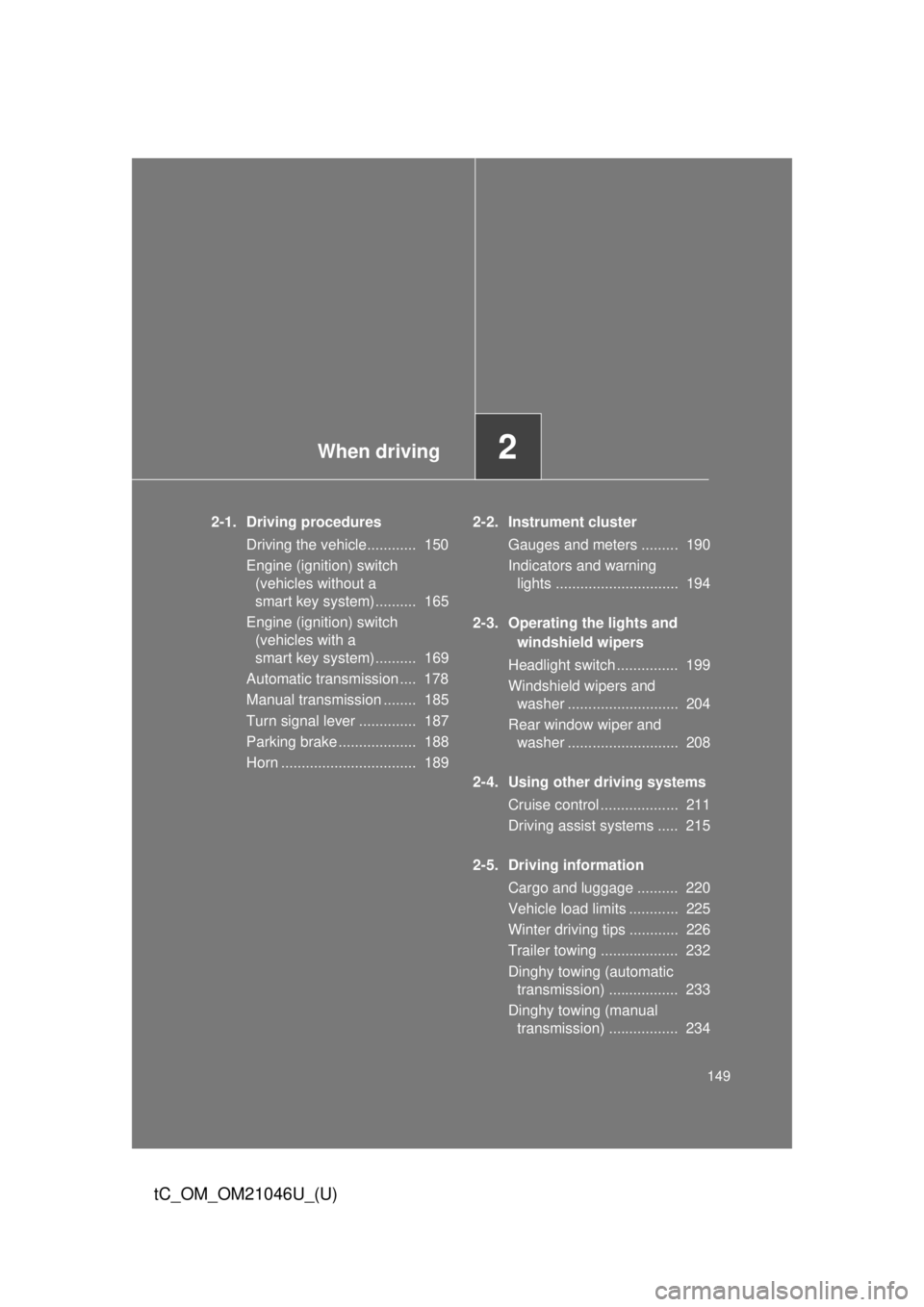
When driving2
149
tC_OM_OM21046U_(U)
2-1. Driving proceduresDriving the vehicle............ 150
Engine (ignition) switch (vehicles without a
smart key system).......... 165
Engine (ignition) switch (vehicles with a
smart key system).......... 169
Automatic transmission .... 178
Manual transmission ........ 185
Turn signal lever .............. 187
Parking brake ................... 188
Horn ................................. 189 2-2. Instrument cluster
Gauges and meters ......... 190
Indicators and warning lights .............................. 194
2-3. Operating the lights and windshield wipers
Headlight switch ............... 199
Windshield wipers and washer ........................... 204
Rear window wiper and washer ........................... 208
2-4. Using other driving systems Cruise control ................... 211
Driving assist systems ..... 215
2-5. Driving information Cargo and luggage .......... 220
Vehicle load limits ............ 225
Winter driving tips ............ 226
Trailer towing ................... 232
Dinghy towing (automatic transmission) ................. 233
Dinghy towing (manual transmission) ................. 234
Page 152 of 488
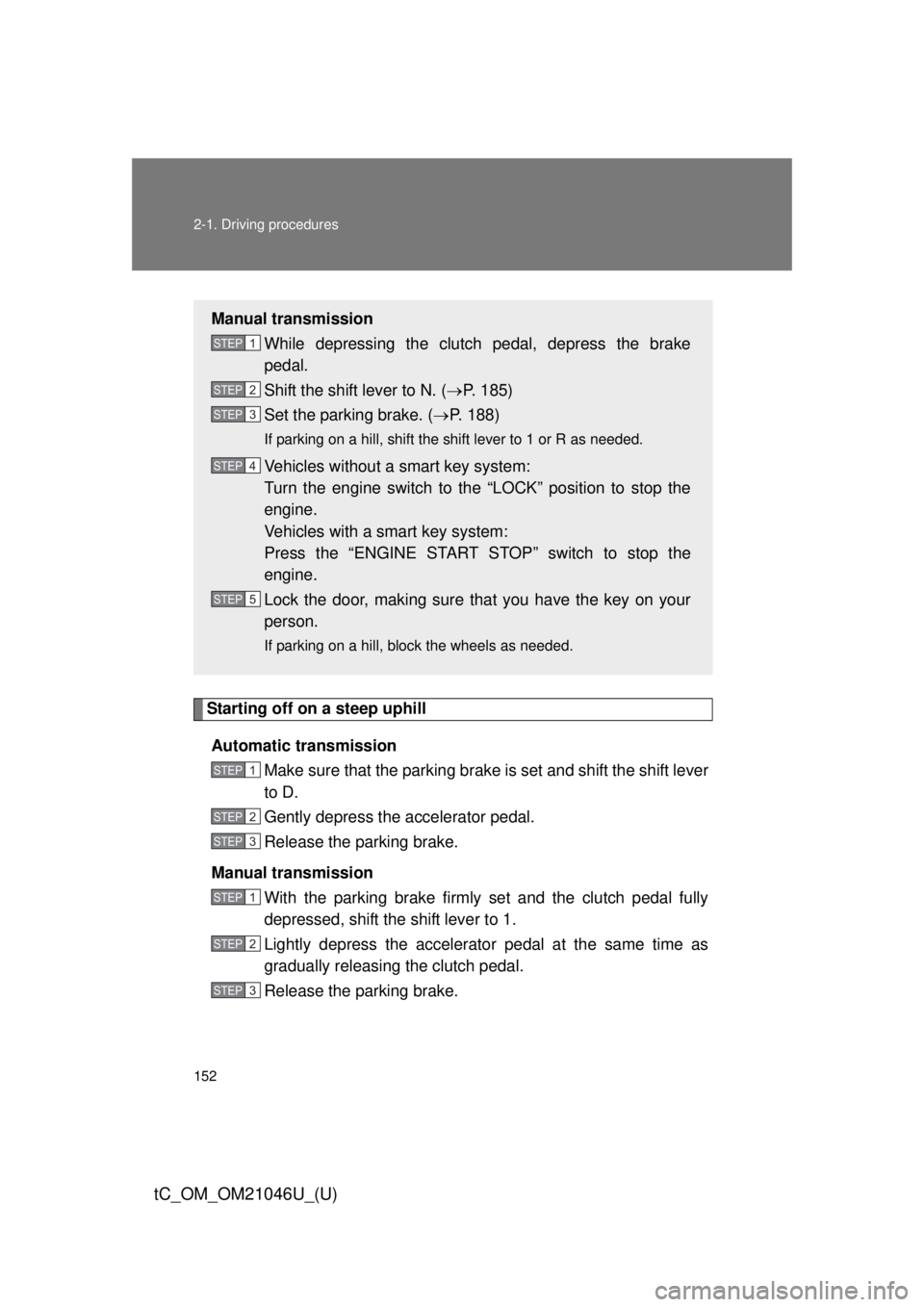
152 2-1. Driving procedures
tC_OM_OM21046U_(U)
Starting off on a steep uphillAutomatic transmission Make sure that the parking brake is set and shift the shift lever
to D.
Gently depress the accelerator pedal.
Release the parking brake.
Manual transmission With the parking brake firmly set and the clutch pedal fully
depressed, shift the shift lever to 1.
Lightly depress the accelerator pedal at the same time as
gradually releasing the clutch pedal.
Release the parking brake.
Manual transmissionWhile depressing the clutch pedal, depress the brake
pedal.
Shift the shift lever to N. ( P. 185)
Set the parking brake. ( P. 188)
If parking on a hill, shift the shift lever to 1 or R as needed.
Vehicles without a smart key system:
Turn the engine switch to the “LOCK” position to stop the
engine.
Vehicles with a smart key system:
Press the “ENGINE START STOP” switch to stop the
engine.
Lock the door, making sure that you have the key on your
person.
If parking on a hill, block the wheels as needed.
STEP 1
STEP 2
STEP 3
STEP 4
STEP 5
STEP 1
STEP 2
STEP 3
STEP 1
STEP 2
STEP 3
Page 155 of 488
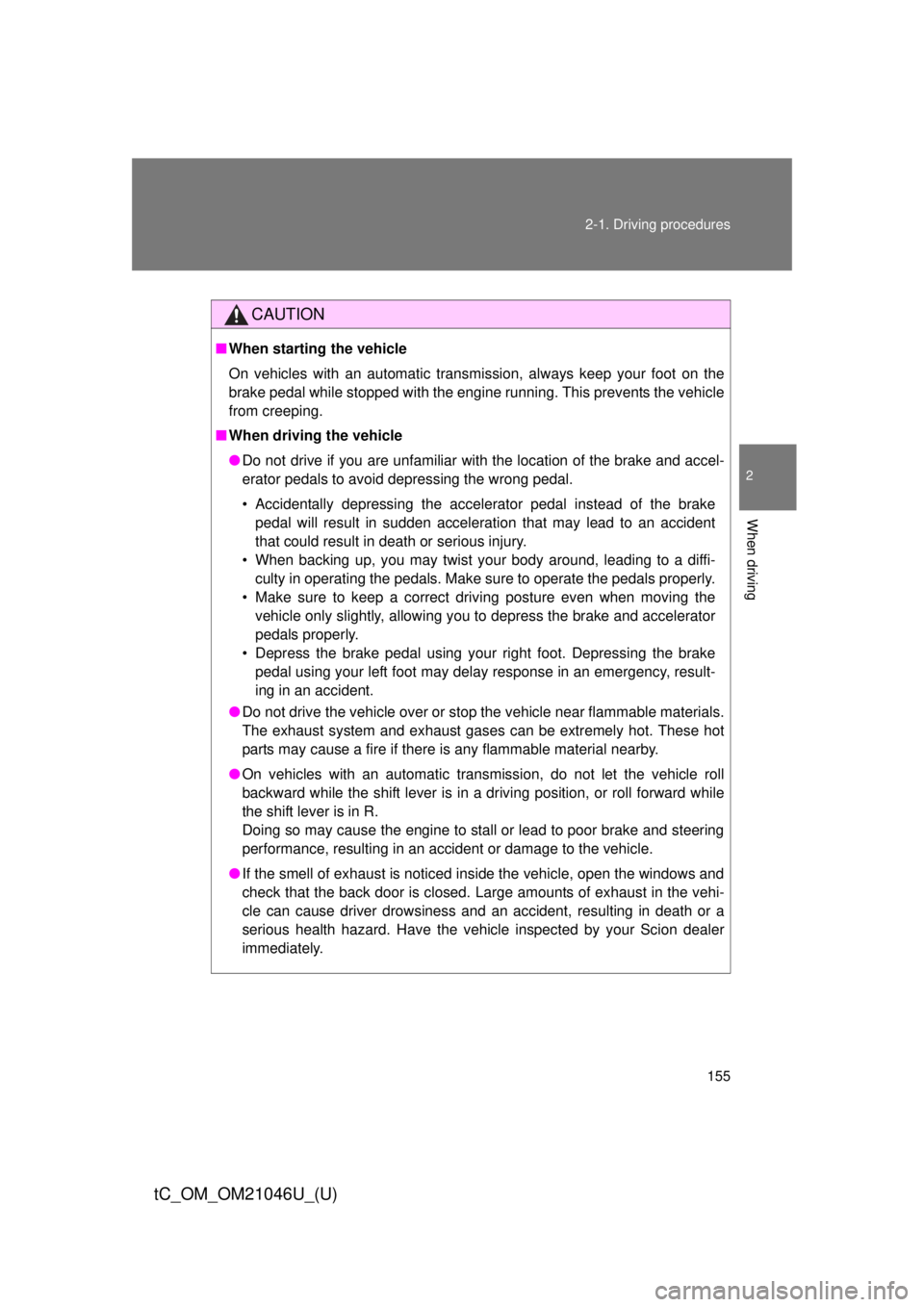
155
2-1. Driving procedures
2
When driving
tC_OM_OM21046U_(U)
CAUTION
■
When starting the vehicle
On vehicles with an automatic transmission, always keep your foot on the
brake pedal while stopped with the engine running. This prevents the vehicle
from creeping.
■ When driving the vehicle
●Do not drive if you are unfamiliar with the location of the brake and accel-
erator pedals to avoid depressing the wrong pedal.
• Accidentally depressing the accelerator pedal instead of the brake
pedal will result in sudden acceleration that may lead to an accident
that could result in death or serious injury.
• When backing up, you may twist your body around, leading to a diffi- culty in operating the pedals. Make sure to operate the pedals properly.
• Make sure to keep a correct driving posture even when moving the vehicle only slightly, allowing you to depress the brake and accelerator
pedals properly.
• Depress the brake pedal using your right foot. Depressing the brake pedal using your left foot may delay response in an emergency, result-
ing in an accident.
● Do not drive the vehicle over or st op the vehicle near flammable materials.
The exhaust system and exhaust gases can be extremely hot. These hot
parts may cause a fire if there is any flammable material nearby.
● On vehicles with an automatic transmission, do not let the vehicle roll
backward while the shift lever is in a driving position, or roll forward while
the shift lever is in R.
Doing so may cause the engine to stall or lead to poor brake and steering
performance, resulting in an accident or damage to the vehicle.
● If the smell of exhaust is noticed inside the vehicle, open the windows and
check that the back door is closed. Large amounts of exhaust in the vehi-
cle can cause driver drowsiness and an accident, resulting in death or a
serious health hazard. Have the vehicle inspected by your Scion dealer
immediately.
Page 157 of 488
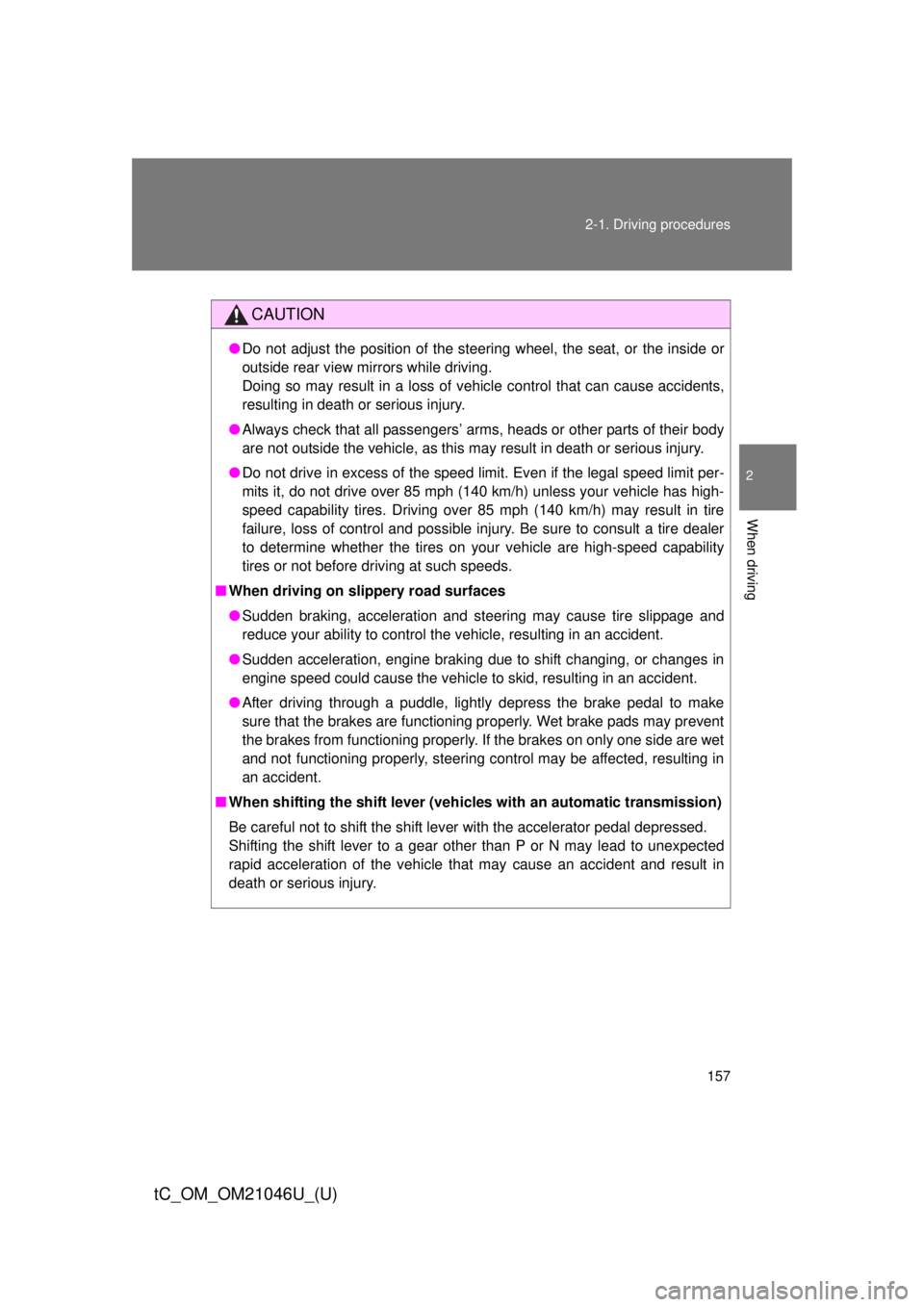
157
2-1. Driving procedures
2
When driving
tC_OM_OM21046U_(U)
CAUTION
●
Do not adjust the position of the steering wheel, the seat, or the inside or
outside rear view mirrors while driving.
Doing so may result in a loss of vehicle control that can cause accidents,
resulting in death or serious injury.
● Always check that all passengers’ arms, heads or other parts of their body
are not outside the vehicle, as this may result in death or serious injury.
● Do not drive in excess of the speed limit. Even if the legal speed limit per-
mits it, do not drive over 85 mph (140 km/h) unless your vehicle has high-
speed capability tires. Driving over 85 mph (140 km/h) may result in tire
failure, loss of control and possible injury. Be sure to consult a tire dealer
to determine whether the tires on your vehicle are high-speed capability
tires or not before driving at such speeds.
■ When driving on slippery road surfaces
●Sudden braking, acceleration and steering may cause tire slippage and
reduce your ability to control the vehicle, resulting in an accident.
● Sudden acceleration, engine braking due to shift changing, or changes in
engine speed could cause the vehicle to skid, resulting in an accident.
● After driving through a puddle, lightly depress the brake pedal to make
sure that the brakes are functioning properly. Wet brake pads may prevent
the brakes from functioning properly. If the brakes on only one side are wet
and not functioning properly, steering control may be affected, resulting in
an accident.
■ When shifting the shift lever (vehicles with an automatic transmission)
Be careful not to shift the shift lever with the accelerator pedal depressed.
Shifting the shift lever to a gear other than P or N may lead to unexpected
rapid acceleration of the vehicle that may cause an accident and result in
death or serious injury.
Page 159 of 488
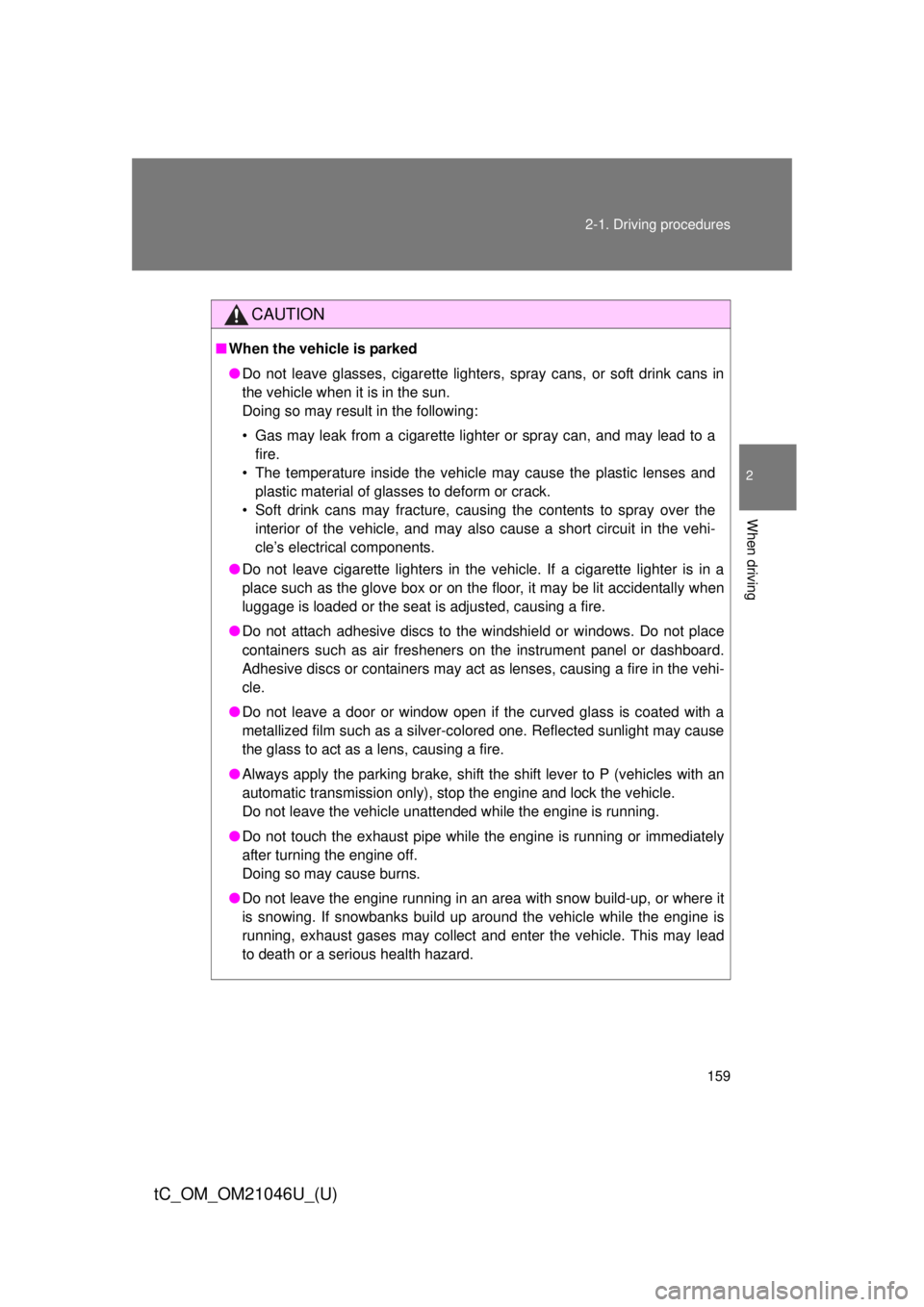
159
2-1. Driving procedures
2
When driving
tC_OM_OM21046U_(U)
CAUTION
■
When the vehicle is parked
●Do not leave glasses, cigarette lighters, spray cans, or soft drink cans in
the vehicle when it is in the sun.
Doing so may result in the following:
• Gas may leak from a cigarette lighter or spray can, and may lead to a
fire.
• The temperature inside the vehicle may cause the plastic lenses and plastic material of glasses to deform or crack.
• Soft drink cans may fracture, causing the contents to spray over the interior of the vehicle, and may also cause a short circuit in the vehi-
cle’s electrical components.
● Do not leave cigarette lighters in the vehicle. If a cigarette lighter is in a
place such as the glove box or on the floor, it may be lit accidentally when
luggage is loaded or the seat is adjusted, causing a fire.
● Do not attach adhesive discs to the windshield or windows. Do not place
containers such as air fresheners on the instrument panel or dashboard.
Adhesive discs or containers may act as lenses, causing a fire in the vehi-
cle.
● Do not leave a door or window open if the curved glass is coated with a
metallized film such as a silver-colored one. Reflected sunlight may cause
the glass to act as a lens, causing a fire.
● Always apply the parking brake, shift the shift lever to P (vehicles with an
automatic transmission only), stop the engine and lock the vehicle.
Do not leave the vehicle unattended while the engine is running.
● Do not touch the exhaust pipe while the engine is running or immediately
after turning the engine off.
Doing so may cause burns.
● Do not leave the engine running in an area with snow build-up, or where it
is snowing. If snowbanks build up around the vehicle while the engine is
running, exhaust gases may collect and enter the vehicle. This may lead
to death or a serious health hazard.
Page 188 of 488
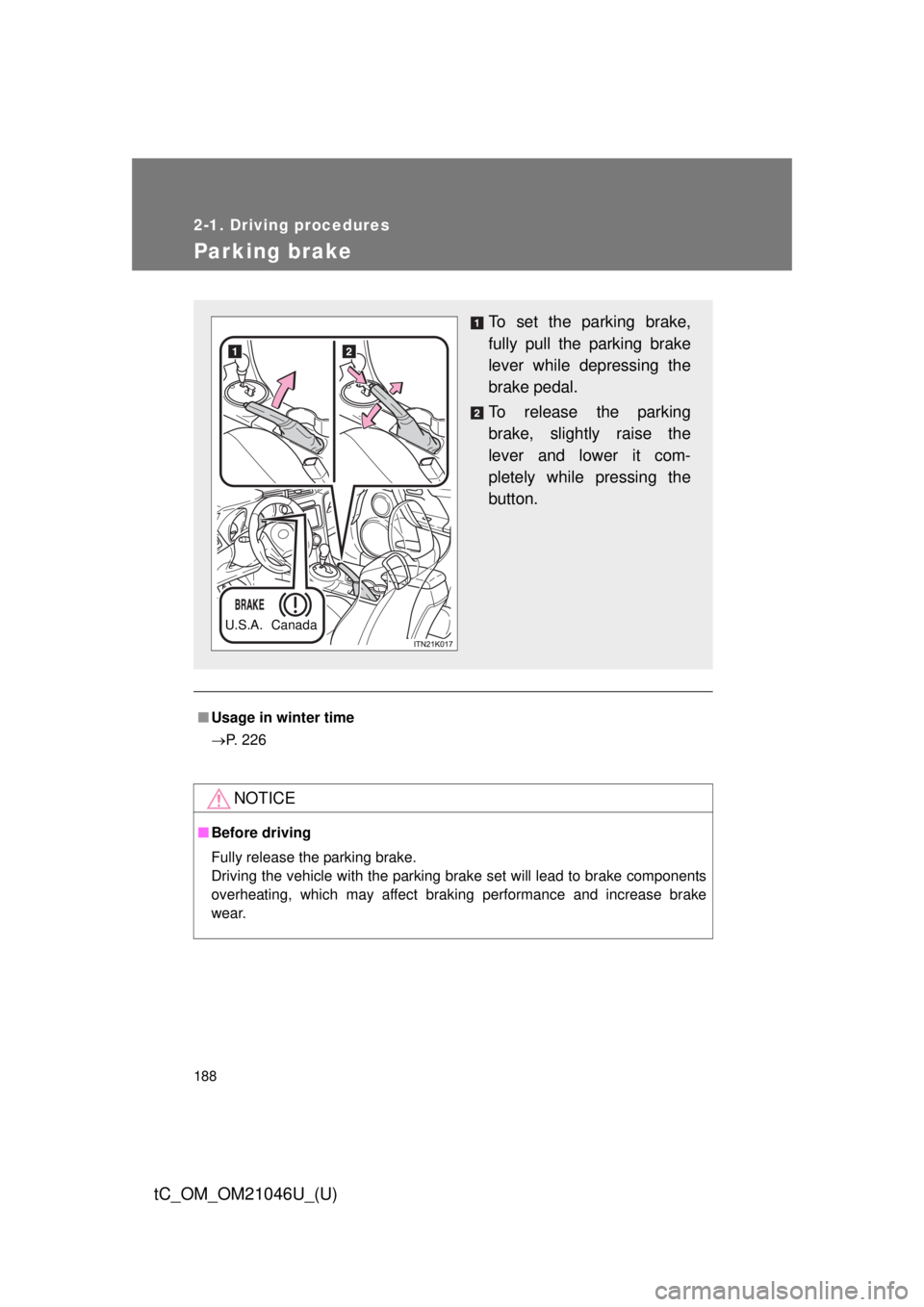
188
2-1. Driving procedures
tC_OM_OM21046U_(U)
Parking brake
■Usage in winter time
P. 226
NOTICE
■Before driving
Fully release the parking brake.
Driving the vehicle with the parking brake set will lead to brake components
overheating, which may affect braking performance and increase brake
wear.
To set the parking brake,
fully pull the parking brake
lever while depressing the
brake pedal.
To release the parking
brake, slightly raise the
lever and lower it com-
pletely while pressing the
button.
U.S.A. Canada
Page 201 of 488
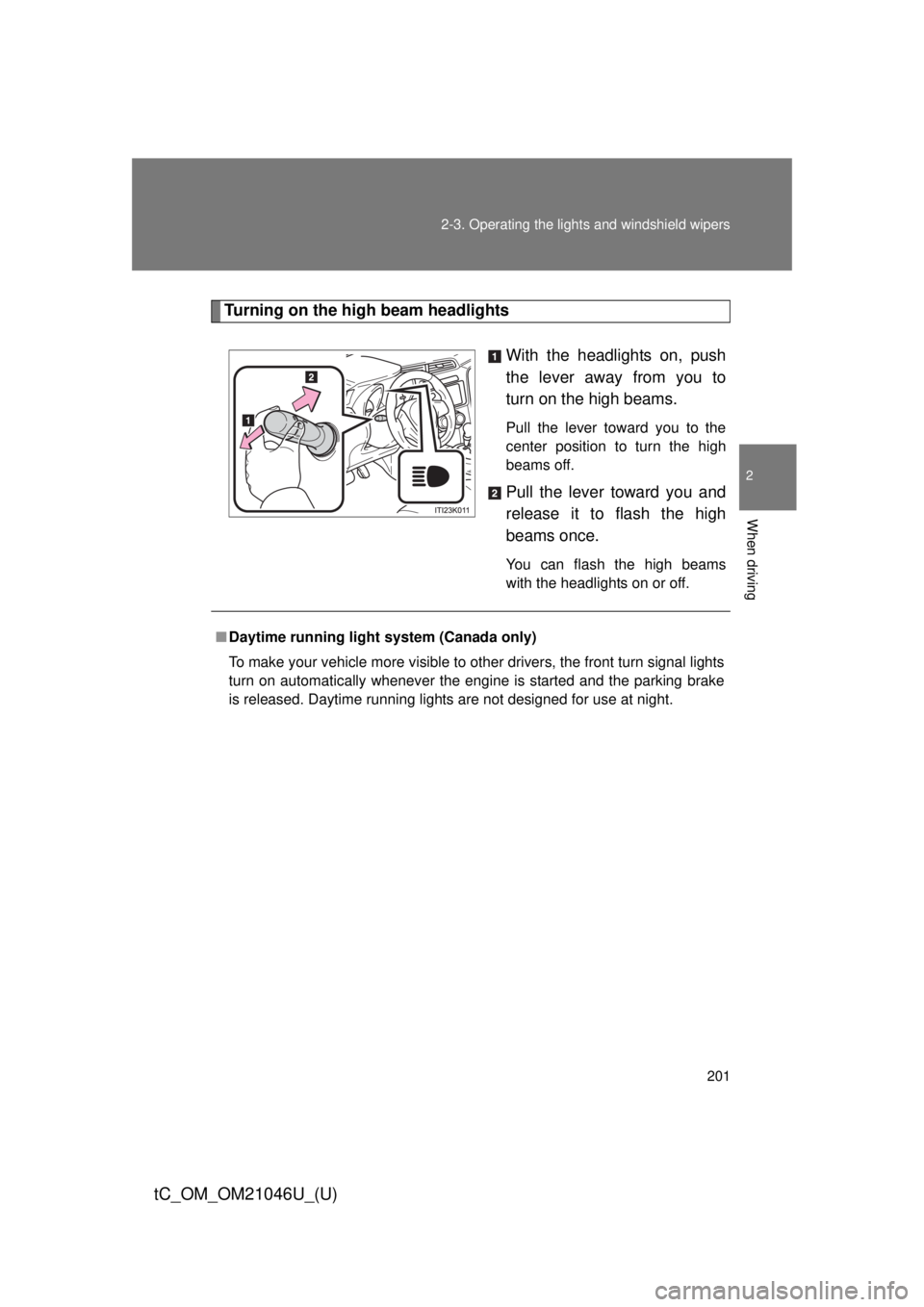
201
2-3. Operating the lights and windshield wipers
2
When driving
tC_OM_OM21046U_(U)
Turning on the high beam headlights
With the headlights on, push
the lever away from you to
turn on the high beams.
Pull the lever toward you to the
center position to turn the high
beams off.
Pull the lever toward you and
release it to flash the high
beams once.
You can flash the high beams
with the headlights on or off.
■Daytime running light system (Canada only)
To make your vehicle more visible to other drivers, the front turn signal lights
turn on automatically whenever the engine is started and the parking brake
is released. Daytime running lights are not designed for use at night.
Page 215 of 488
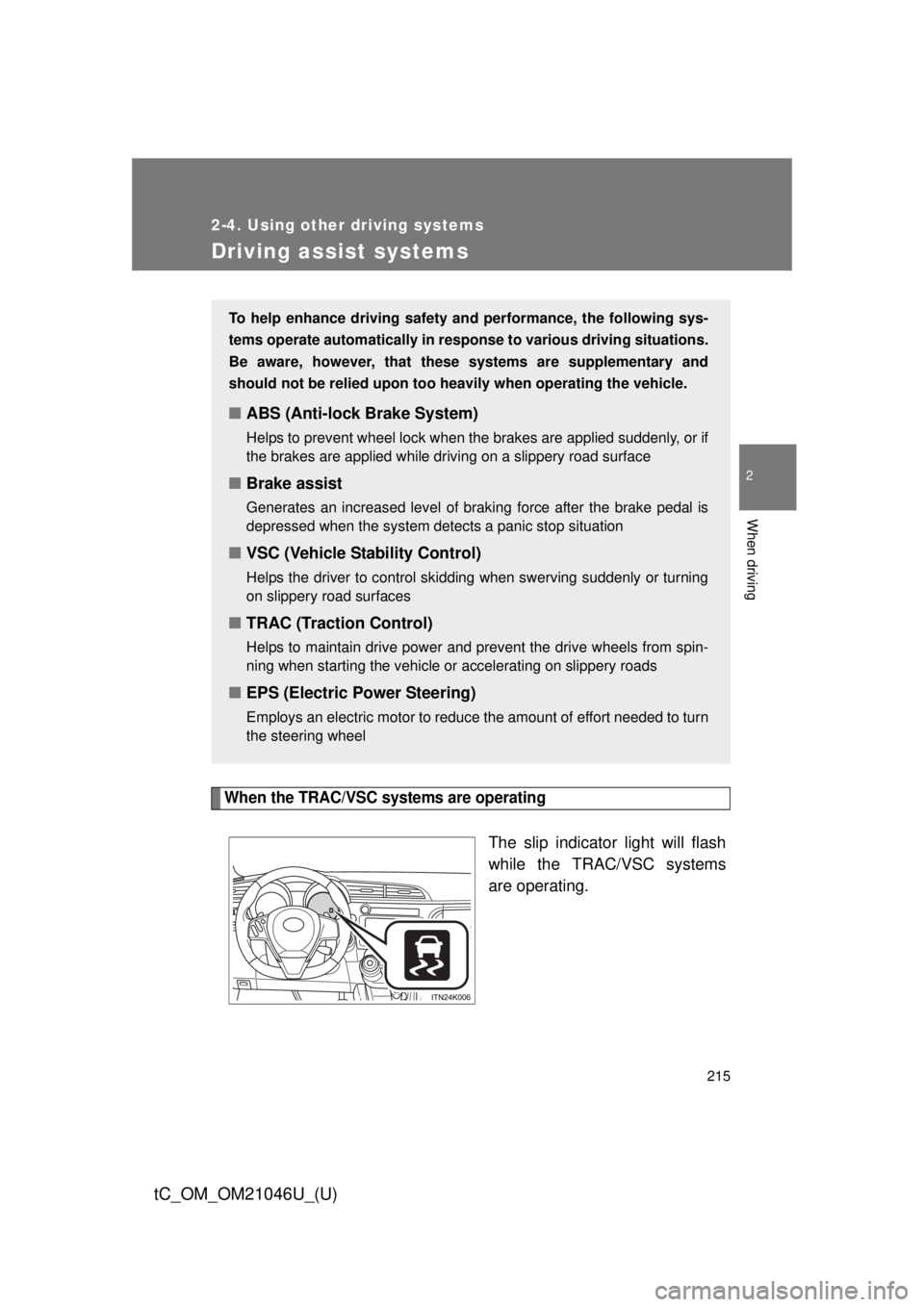
215
2-4. Using other driving systems
2
When driving
tC_OM_OM21046U_(U)
Driving assist systems
When the TRAC/VSC systems are operating
The slip indicator light will flash
while the TRAC/VSC systems
are operating.
To help enhance driving safety and performance, the following sys-
tems operate automatically in res ponse to various driving situations.
Be aware, however, that these systems are supplementary and
should not be relied upon too heavi ly when operating the vehicle.
■ABS (Anti-lock Brake System)
Helps to prevent wheel lock when the brakes are applied suddenly, or if
the brakes are applied while driving on a slippery road surface
■Brake assist
Generates an increased level of braking force after the brake pedal is
depressed when the system detects a panic stop situation
■VSC (Vehicle Stability Control)
Helps the driver to control skidding when swerving suddenly or turning
on slippery road surfaces
■TRAC (Traction Control)
Helps to maintain drive power and prevent the drive wheels from spin-
ning when starting the vehicle or accelerating on slippery roads
■EPS (Electric Power Steering)
Employs an electric motor to reduce the amount of effort needed to turn
the steering wheel
Page 217 of 488

217
2-4. Using other
driving systems
2
When driving
tC_OM_OM21046U_(U)
■Sounds and vibrations caused by the ABS, brake assist, TRAC and
VSC systems
●A sound may be heard from the engine compartment when the brake
pedal is depressed repeatedly, when the engine is started or just after the
vehicle begins to move. This sound does not indicate that a malfunction
has occurred in any of these systems.
● Any of the following conditions may occur when the above systems are
operating. None of these indicates that a malfunction has occurred.
• Vibrations may be felt through the vehicle body and steering.
• A motor sound may be heard after the vehicle comes to a stop.
• The brake pedal may pulsate slightly after the ABS is activated.
• The brake pedal may move down slightly after the ABS is activated.
■ EPS operation sound
When the steering wheel is operated, a motor sound (whirring sound) may
be heard. This does not indicate a malfunction.
■ Automatic reactivation of TRAC and VSC systems
After turning the TRAC and VSC systems off, the systems will be automati-
cally re-enabled in the following situations:
●When the engine switch is turned to the “LOCK” position (vehicles with-
out a smart key system) or the “ENGINE START STOP” switch is turned
off (vehicles with a smart key system)
● If only the TRAC system is turned off, the TRAC will turn on when vehicle
speed increases
If both the TRAC and VSC systems are turned off, automatic re-enabling
will not occur when vehicle speed increases.
■ Reduced effectiveness of the EPS system
The effectiveness of the EPS system is reduced to prevent the system from
overheating when there is frequent steering input over an extended period of
time. The steering wheel may feel heavy as a result. Should this occur,
refrain from excessive steering input or stop the vehicle and turn the engine
off. The EPS system should return to normal within 10 minutes.